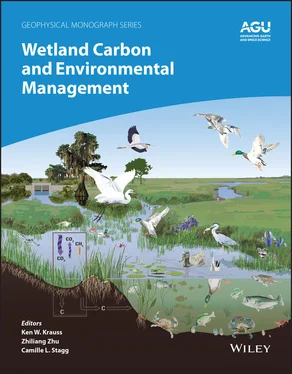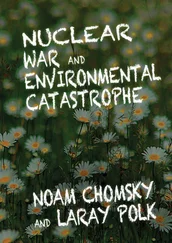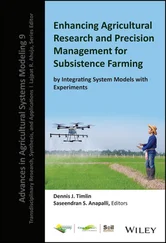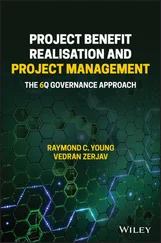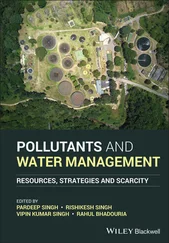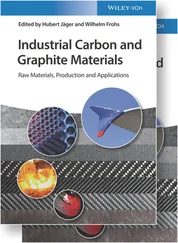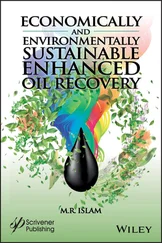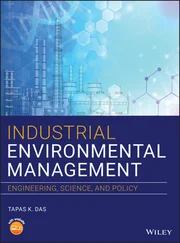431 Wang, H., Richardson, C. J., & Ho, M. (2015). Dual controls on carbon loss during drought in peatlands. Nature Climate Change, 5(6), 584–587. https://doi.org/10.1038/nclimate2643
432 Wang, T., & Peverly, J. H. (1999). Iron oxidation states on root surfaces of a wetland plant (Phragmites australis). Soil Science Society of America Journal, 63(1), 247–252. https://doi.org/10.2136/sssaj1999.03615995006300010036x
433 Wang, Y., Wang, H., He, J. S., & Feng, X. (2017). Iron‐mediated soil carbon response to water‐table decline in an alpine wetland. Nature Communications, 8(May), 1–9. https://doi.org/10.1038/ncomms15972
434 Wang, Z. A., & Cai, W.‐J. (2004). Carbon dioxide degassing and inorganic carbon export from a marsh‐dominated estuary (the Duplin River): A marsh CO2 pump. Limnology and Oceanography, 49(2), 341–354. https://doi.org/10.4319/lo.2004.49.2.0341
435 Wantzen, K. M., De Arruda Machado, F., Voss, M., Boriss, H., & Junk, W. J. (2002). Seasonal isotopic shifts in fish of the Pantanal wetland, Brazil. Aquatic Sciences, 64(3), 239–251. https://doi.org/10.1007/PL00013196
436 Watson, A., & Nedwell, D. B. (1998). Methane production and emission from peat: The influence of anions (sulphate, nitrate) from acid rain. Atmospheric Environment, 32, 3239–3245. https://doi.org/10.1016/S1352‐2310(97)00501‐3
437 Webster, J. R., & Benfield, E. F. (1986). Vascular plant breakdown in freshwater ecosystems. Annual Review of Ecology and Systematics, 17, 567–594. https://doi.org/10.1146/annurev.es.17.110186.003031
438 Weiss, J. V, Emerson, D., & Megonigal, J. P. (2004). Geochemical control of microbial Fe(III) reduction potential in wetlands: Comparison of the rhizosphere to non‐rhizosphere soil. FEMS Microbiology Ecology, 48, 89–100. https://doi.org/10.1016/j.femsec.2003.12.014
439 Weiss, J. V, Emerson, D., & Megonigal, J. P. (2005). Rhizosphere iron(III) deposition and reduction in a Juncus effusus L.‐dominated wetland. Soil Science Society of America Journal, 69(6), 1861–1870. https://doi.org/10.2136/sssaj2005.0002
440 Weston, N. B., & Joye, S. B. (2005). Temperature‐driven decoupling of key phases of organic matter degradation in marine sediments. Proceedings of the National Academy of Sciences, 102(47), 17036–17040. https://doi.org/10.1073/pnas.0508798102
441 Weston, N. B., Vile, M. A., Neubauer, S. C., & Velinsky, D. J. (2011). Accelerated microbial organic matter mineralization following salt‐water intrusion into tidal freshwater marsh soils. Biogeochemistry, 102(1), 135–151. https://doi.org/10.1007/s10533‐010‐9427‐4
442 Weston, N. B., Neubauer, S. C., Velinsky, D. J., & Vile, M. A. (2014). Net ecosystem carbon exchange and the greenhouse gas balance of tidal marshes along an estuarine salinity gradient. Biogeochemistry, 120(1–3), 163–189. https://doi.org/10.1007/s10533‐014‐9989‐7
443 Wetzel, R. G. (1992). Gradient‐dominated ecosystems: sources and regulatory functions of dissolved organic matter in freshwater ecosystems. Hydrobiologia, 229(1), 181–198. https://doi.org/10.1007/BF00007000
444 Whiting, G. J., & Chanton, J. P. (1992). Plant‐dependent CH4 emission in a subarctic Canadian fen. Global Biogeochemical Cycles, 6(3), 225–231. https://doi.org/10.1029/92GB00710
445 Whiting, G. J., & Chanton, J. P. (1993). Primary production control of methane emission from wetlands. Nature, 364(6440), 794–795. https://doi.org/10.1038/364794a0
446 Whiting, G. J., & Chanton, J. P. (2001). Greenhouse carbon balance of wetlands: Methane emission versus carbon sequestration. Tellus B, 53(5), 521–528. https://doi.org/10.1034/j.1600‐0889.2001.530501.x
447 Wilkinson, B. H., & McElroy, B. J. (2007). The impact of humans on continental erosion and sedimentation. Geological Society of America Bulletin, 119(1–2), 140–156. https://doi.org/10.1130/B25899.1
448 Williams, C. J., Shingara, E. A., & Yavitt, J. B. (2000). Phenol oxidase activity in peatlands in New York state: Response to summer drought and peat type. Wetlands, 20(2), 416–421. https://doi.org/10.1672/0277‐5212(2000)020[0416:POAIPI]2.0.CO;2
449 Williamson, C. E., Morris, D. P., Pace, M. L., & Olson, O. G. (1999). Dissolved organic carbon and nutrients as regulators of lake ecosystems: Resurrection of a more integrated paradigm. Limnology and Oceanography, 44(3 II), 795–803 https://doi.org/10.4319/lo.1999.44.3_part_2.0795
450 Williamson, C. E., Overholt, E. P., Pilla, R. M., Leach, T. H., Brentrup, J. A., Knoll, L. B., et al. (2015). Ecological consequences of long‐term browning in lakes. Scientific Reports, 5(November), 1–10. https://doi.org/10.1038/srep18666
451 Wilson, D., Blain, D., Cowenberg, J., Evans, C. D., Murdiyarso, D., Page, S. E., et al. (2016). Greenhouse gas emission factors associated with rewetting of organic soils. Mires and Peat, 17(04), 1–28. https://doi.org/10.19189/MaP.2016.OMB.222
452 Winter, T. C. (1988). A conceptual framework for assessing cumulative impacts on the hydrology of nontidal wetlands. Environmental Management, 12(5), 605–620. https://doi.org/10.1007/BF01867539
453 Wolf, A. A., Drake, B. G., Erickson, J. E., & Megonigal, J. P. (2007). An oxygen‐mediated positive feedback between elevated carbon dioxide and soil organic matter decomposition in a simulated anaerobic wetland. Global Change Biology, 13(9), 2036–2044. https://doi.org/10.1111/j.1365‐2486.2007.01407.x
454 Wolf, E. C., Rejmánková, E., & Cooper, D. J. (2019). Wood chip soil amendments in restored wetlands affect plant growth by reducing compaction and increasing dissolved phenolics. Restoration Ecology, 27(5), 1128–1136. https://doi.org/10.1111/rec.12942
455 Worrall, F., Armstrong, A., & Adamson, J. K. (2007). The effects of burning and sheep‐grazing on water table depth and soil water quality in a upland peat. Journal of Hydrology, 339(1–2), 1–14. https://doi.org/10.1016/j.jhydrol.2006.12.025
456 Worrall, F., Moody, C. S., Clay, G. D., Burt, T. P., & Rose, R. (2017). The flux of organic matter through a peatland ecosystem: The role of cellulose, lignin, and their control of the ecosystem oxidation state. Journal of Geophysical Research: Biogeosciences, 122(7), 1655–1671. https://doi.org/10.1002/2016JG003697
457 Wright, A. L., & Reddy, K. R. (2001). Phosphorus loading effects on extracellular enzyme activity in Everglades wetland soils. Soil Science Society of America Journal, 65(2), 588–595. https://doi.org/10.2136/sssaj2001.652588x
458 Xiang, W., Wan, X., Yan, S., Wu, Y., & Bao, Z. (2013). Inhibitory effects of drought induced acidification on phenol oxidase activities in Sphagnum‐dominated peatland. Biogeochemistry, 116(1–3), 293–301. https://doi.org/10.1007/s10533‐013‐9859‐8
459 Xu, S., Liu, X., Li, X., & Tian, C. (2019). Soil organic carbon changes following wetland restoration: A global meta‐analysis. Geoderma. Elsevier. https://doi.org/10.1016/j.geoderma.2019.06.027
460 Yao, H., Conrad, R., Wassmann, R., & Neue, H. U. (1999). Effect of soil characteristics on sequential reduction and methane production in sixteen rice paddy soils from China, the Philippines, and Italy. Biogeochemistry, 47(3), 269–295. https://doi.org/10.1007/BF00992910
461 Ye, R., Jin, Q., Bohannan, B., Keller, J. K., McAllister, S. A., & Bridgham, S. D. (2012). pH controls over anaerobic carbon mineralization, the efficiency of methane production, and methanogenic pathways in peatlands across an ombrotrophic‐minerotrophic gradient. Soil Biology and Biochemistry, 54, 36–47. https://doi.org/10.1016/j.soilbio.2012.05.015
462 Zang, X., Van Heemst, J. D. H., Dria, K. J., & Hatcher, P. G. (2000). Encapsulation of protein in humic acid from a histosol as an explanation for the occurrence of organic nitrogen in soil and sediment. Organic Geochemistry, 31(7–8), 679–695. https://doi.org/10.1016/S0146‐6380(00)00040‐1
Читать дальше
